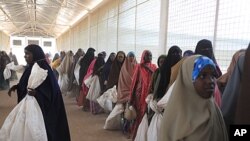In the maternity ward at a hospital on the Hagadera refugee camp in Dadaab, Kenya, women refugees lay on beds nursing newborns or waiting to give birth.
Katlum Mohammed, 22-years-old, has just arrived at the camp from central Somalia. She lays on her side, nine months pregnant with her first child.
For her, this has not been an easy journey. She said her husband died in the fighting between government forces and al-Shabab. “He was not part of any group,” she says, “he was a civilian. I have undergone a lot, and my way here was so tiring.”
And while walking to the border in Kenya, she and the others in a group of six were robbed, again, by Al-Shabaab.
Her story is unfortunately not unusual.
The maternity clinic here, run by the International Rescue Committee, has seen a steep rise in pregnant refugees since June, as a worsening drought in East Africa forced many to flee.
Before the sudden influx, doctors at the clinic say they were delivering about 40 babies a week. Now it is twice that.
And while the health care is good for now, most new arrivals are unable to find space in the overcrowded camps, so they are pushed to the lawless outskirts.
Aisha Abdul-Karim lives on the edge of the Hagadera camp. She said, “we have had problems here since we arrived four days ago. I have nothing and am staying with my sister. We do not have space to build a structure. We have nothing.”
It is difficult to police the outskirts of the camp, where new arrivals set up their huts anywhere they can find a piece of land.
Sinead Murray is the gender based violence program manager for the International Rescue Commmittee. She said women here on the outskirts are the most vulnerable.
“It's at nighttime, when women and girls are sleeping in their tents, if they have tents and that men are coming into those, but also for those that do not have tents, that they're in these makeshift tukus (structure made out of sticks) that anybody can just lift the sheet and enter it," she said.
Murray and her colleague Liz Pender routinely patrol these areas looking for potential risks. That could include a settlement that is too close to the bushes, a long walk for firewood, and the placement of latrines.
“Even when there are latrines, they're going to the forest, which is very dangerous, they're being attacked in the forest. We just passed a row of latrines that are right in the middle of a walkway, I imagine that especially adolescent girls wouldn't be comfortable using a latrine that's right in the middle of a walkway," said Pender.
Murray and Pender keep records of their findings in the outskirts so that authorities have a reference for securing these areas. But, international organizations are having to keep their distance, since the land is not actually part of the camps, but is owned by the local communities.
And while the government has indicated it is ready to open an existing site to new refugees, such a move is unlikely to occur any time soon.
So with more than one thousand refugees pouring in every day, many of them women, the crisis on the outskirts is only likely to get worse.
No Safe Place for Somali Women Refugees in Kenya
- By Gabe Joselow











